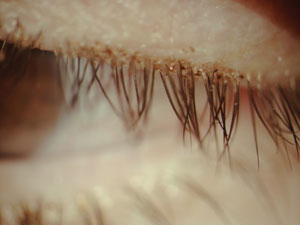Contact lens wearers have greater numbers of Demodex than nonwearers, according to a study from optometric researchers at the University of New South Wales in Australia.
The study findings, published in June’s Optometry & Vision Science, did not uncover why contact lens wearers have more Demodex in their lashes. But the investigators speculate that contact lens wear—which is associated with colonization of lid margins by Staphylococcus epidermidis, Propionibacterium acnes, Corynebacteria and Staphylococcus aureus—may provide a more favorable environment for Demodex mites to proliferate.
 | |
| Collarettes are a predictable sign of Demodex. Image: Elyse L. Chaglasian, OD. |
“It is possible that the contact lens may act as a vector for microorganisms that offer an environment more favorable to accumulate excessive bacteria, which may further lead toward Demodex infestation,” the authors wrote.
The study enrolled 40 participants, half of whom were contact lens wearers and half were not. Using confocal microscopy, investigators found Demodex in 90% of lens wearers and in 65% of nonwearers. Conventional light microscopy detected lower numbers in both groups, although contact lens wearers still had more Demodex (70%) than did nonwearers (60%).
As expected, the number of Demodex tended to increase with participants’ ages. But, surprisingly, Demodex did not appear to affect ocular comfort or cause any clinical signs. The investigators say further research is needed to confirm these findings.
Yet, they add, “manufacturers of contact lens care products may want to formulate future products with these results in mind.”
Jalbert I, Rejab S. Increased numbers of Demodex in contact lens wearers. Optom Vis Sci. 2015 Jun;92(6):671-8.
